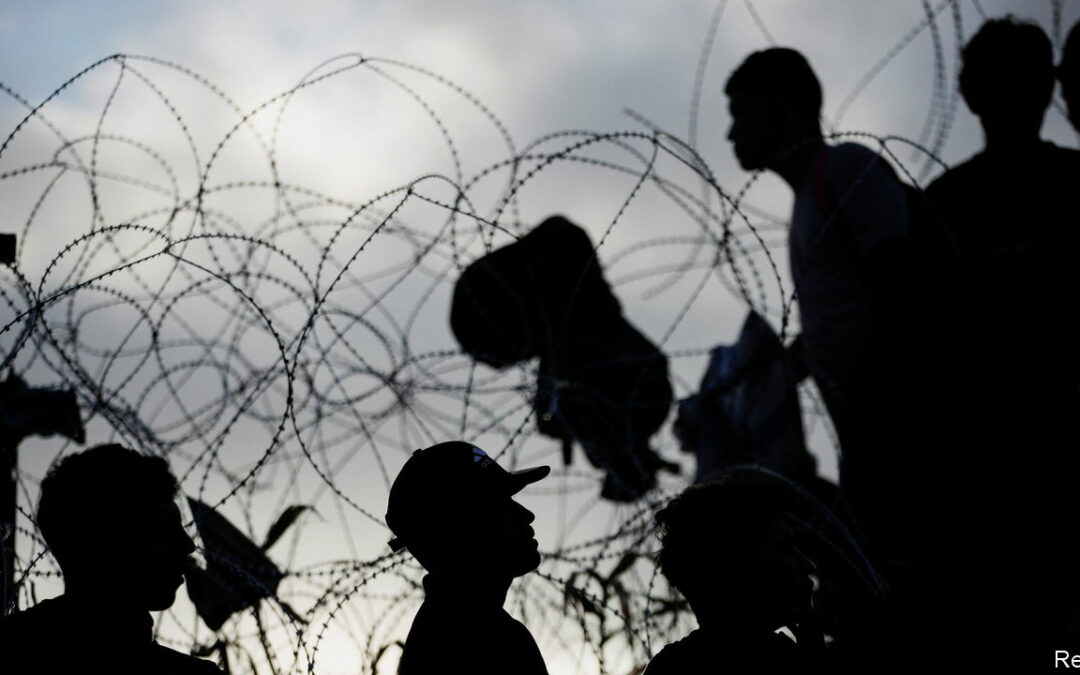ASYLUM CLAIMS in Western countries are surging. EU members are on track to receive 1m applications this year, more than at any time since the migrant crisis of 2015-16. More than 800,000 have been lodged in America in the past year, an annual jump of nearly two-thirds. Politicians are under pressure to demonstrate control to voters. Some hope to sidestep the problem by sending asylum-seekers to have their claims processed abroad. But asylum-offshoring rarely succeeds. What is it, and why is it so hard to pull off?
Signatories to the Refugee Convention of 1951 and its protocol of 1967—most countries in the world—are obliged to hear claims for asylum from anyone who enters their territory. But hearings require time and money, and deporting failed asylum-seekers is hard. For rich Western countries far from war zones, the attractions of keeping asylum-seekers from their shores are obvious.
What migration experts call “externalisation” has long been a feature of the global asylum system. Typical schemes involve rich “destination” governments encouraging countries through which migrants travel to stop them leaving. Examples include American interdiction of potential asylum-seekers at sea or the EU’s deal with Turkey, struck in 2016. The EU has also paid the Libyan coastguard, an institution riddled with criminals, hundreds of millions of euros to keep migrants from crossing the Mediterranean. It is keen to strike more such deals, mainly with north African countries.
But many Western governments want to do more to reduce their asylum burden. More ambitious models rope in “third” countries to which asylum-seekers have no pre-existing link. Under Australia’s so-called Pacific solution, the government paid Papua New Guinea and Nauru, two poor Pacific countries, to take in asylum-seekers who had sought to reach Australia. It eventually barred anyone removed in this way from resettlement in Australia for life. The policy, which ran from 2001 to 2008 and was revived in modified form in 2013, saw the numbers of asylum-seekers arriving by sea dwindle to almost nothing. But it came at a tremendous cost. There were well-documented cases of abuse inflicted on asylum-seekers. And by one estimate the Australian government spent at least A$1bn ($660m) a year managing the scheme. No transfers have taken place since 2014; Australia has focused instead on pushing back vessels to the country they embarked from. Although the scheme has been wound down, 80 migrants remain in Papua New Guinea.
For decades European governments have looked to Australia for inspiration. But the plans of countries like Austria, Germany and the Netherlands to pay non-EU states to process their asylum claimants have never overcome the many diplomatic and legal hurdles. The European Court of Human Rights (ECHR) looks askance at anything that might resemble refoulement, or returning refugees to a place where they may face danger (non-refoulement is the fundamental principle of the Refugee Convention). In 2018 the European Commission said that sending asylum-seekers outside EU territory to have their claims assessed by an EU country was legally “neither possible nor desirable”.
That has not stopped governments from trying. Last month Italy and Albania signed a five-year deal under which Albania, a non-EU member, will take in up to 36,000 asylum-seekers a year who are picked up at sea by Italian authorities. Their claims would be processed under Italian asylum law. Italy says that the scheme will begin by next spring, but details remain scanty. The Council of Europe has raised concerns over the plan’s “legal ambiguities”, although the European Commission has given it a tentative green light. Giorgia Meloni, Italy’s prime minister, says the plan could be a “model” for other EU countries. Germany, which accounts for about one-quarter of EU asylum claims, is paying close attention.
A more radical idea, proposed by the British government, has so far been thwarted. In April 2022 Britain secured agreement from Rwanda to take in asylum-seekers who reach Britain. This is not “offshoring” but rather mass deportation: Britain’s responsibility to the asylum-seekers would end once they landed in Rwanda, which would then be responsible for granting them asylum, should they choose to claim it. The hope is that the prospect of deportation would deter would-be asylum-seekers from entering Britain from France—and that the business models of people-smugglers would thus be undermined.
That seems dubious. Rwanda could take only a fraction of the asylum-seekers who reach British shores in small boats (about 46,000 last year). And there is a contradiction baked into the plan: to be a deterrent, Rwanda must be an undesirable destination for asylum-seekers; to be legal, it must be safe. The plan has fallen foul of several British and European court rulings (Britain remains bound by the ECHR, a non-EU body). In November Britain’s Supreme Court said it feared Rwanda’s rudimentary asylum system would expose claimants to the risk of refoulement. Importantly, though, no court has ruled against the principle of offloading asylum claimants in this fashion. That is why Britain’s government is pressing ahead.
Rwanda has participated in offshoring schemes before. A deal it signed with Denmark last year to take in asylum-seekers remains on the drawing-board. Between 2013 and 2018 Rwanda (and Uganda) took in thousands of mainly Sudanese and Eritrean asylum-seekers from Israel, under a “voluntary” and largely secretive arrangement. Research suggested that many of them fled from Rwanda and Uganda, often hoping to reach Europe. In 2018 the Israeli Supreme Court suspended the programme on human-rights grounds.
No country has made a sustainable success of offloading its asylum responsibilities. That many persist in trying demonstrates how worried governments are by the growing asylum caseload—and just how beleaguered the principle of territorial asylum appears to be. ■









